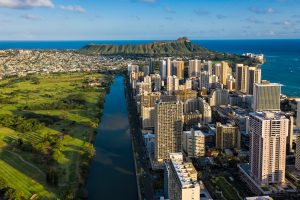Join us on Thursday, October 10, from 1330-1430h, to participate in the Genki Ala Wai Project, a groundbreaking bioremediation effort aimed at restoring the Ala Wai Canal. Interested participants should meet at the Center Concourse, 3rd floor, Hawaii Convention Center at 1330h.
About the event
What are Genki balls?
Genki balls are tennis ball-sized mud balls. They contain a mixture of clay soil, rice bran, molasses, water, and EM•1 solution. For the project, Genki balls are tossed into the Ala Wai canal to digest sludge.
The problem
Over the years, the Ala Wai Canal has been a depository for mud, organic debris, trash, and various pollutants. Due to oxygen deficiency, sludge (rotten, organic material) forms and accumulates. Putrefactive bacteria decompose organic matter in the sludge but also produce harmful gases such as methane, ammonia, and hydrogen sulfide, which produce a toxic environment in the canal.
A potential solution
Bioremediation is the use of living organisms to remove pollutants from soil and water. Nearly all organic compounds can be digested by bacteria. In Japan and Hawaii, there are multiple examples of the use of Effective Microorganisms (EM) in eliminating sludge. The Genki balls made for this project are mud balls that contain EM, and they will sink to the bottom of the canal to digest the sludge.
Why do we use Genki balls? (Genki in Japanese means “healthy”)
To digest sludge, EM must reach the bottom of the canal. According to the USDA, one teaspoon of healthy soil contains one hundred million to one billion bacteria. The soil used in Genki balls provides a “home” for EM as they digest sludge in the canal.
The project goal
The Genki Ala Wai Project is a non-profit project under the Hawaii Exemplary State Foundation. Its aim is to use bioremediation technology to make the Ala Wai Canal fishable and swimmable within seven years. A systemic approach will be used to address flood mitigation in the watershed. The project’s goal is to empower all stakeholders in the ahupua`a to be involved—students, teachers, and the community working together to restore the Ala Wai ecosystem.
About EM
What is EM?
EM stands for Effective Microorganisms – a mixed culture of aerobic and anaerobic microorganisms found in the natural environment. They are primarily lactic acid bacteria, yeast, and phototrophic bacteria.
How does EM work?
After Genki balls embed into the surface of sludge, the fermentative bacteria begin to digest and oxygenate the sludge. At the same time, the phototrophic bacteria consume harmful gases, and contain foul odors.
Is EM safe for the environment?
Lactic acid bacteria and yeast are used in food production, and the US Food and Drug Administration has them on the GRAS (generally recognized as safe) list. All EM microbes are classified as biosafety level 1, meaning they are not known to cause diseases in humans.
Who discovered EM?
Dr. Teruo Higa, emeritus professor of horticulture at Ryukyus University in Okinawa, Japan, discovered EM by accident. After suffering from pesticide poisoning, Dr. Higa began fifteen years of exhaustive research in microorganism mixtures for crop cultivation. EM resulted from his efforts.






